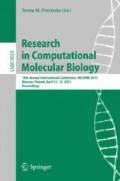Abstract
An active learning method for identifying drug-target interactions is presented which considers the interaction between multiple drugs and multiple targets at the same time. The goal of the proposed method is not simply to predict such interactions from experiments that have already been conducted, but to iteratively choose as few new experiments as possible to improve the accuracy of the predictive model. Kernelized Bayesian matrix factorization (KBMF) is used to model the interactions. We demonstrate on four previously characterized drug effect data sets that active learning driven experimentation using KBMF can result in highly accurate models while performing as few as 14% of the possible experiments, and more accurately than random sampling of an equivalent number. We also provide a method for estimating the accuracy of the current model based on the learning curve; and show how it can be used in practice to decide when to stop an active learning process.
Access this chapter
Tax calculation will be finalised at checkout
Purchases are for personal use only
References
Murphy, R.F.: An active role for machine learning in drug development. Nature Chemical Biology 7, 327–330 (2011)
Gönen, M.: Predicting drug-target interactions from chemical and genomic kernels using Bayesian matrix factorization. Bioinformatics 28, 2304–2310 (2012)
Gönen, M., Khan, S.A., Kaski, S.: Kernelized bayesian matrix factorization. In: International Conference on Machine Learning, pp. 864–872 (2013)
Naik, A.W., Kangas, J.D., Langmead, C.J., Murphy, R.F.: Efficient modeling and active learning discovery of biological responses. PLoS ONE 8(12), 83996 (2013)
Yamanishi, Y., Araki, M., Gutteridge, A., Honda, W., Kanehisa, M.: Prediction of drug-target interaction networks from the integration of chemical and genomic spaces. Bioinformatics 24, i232–i240 (2008)
Author information
Authors and Affiliations
Corresponding author
Editor information
Editors and Affiliations
Rights and permissions
Copyright information
© 2015 Springer International Publishing Switzerland
About this paper
Cite this paper
Temerinac-Ott, M., Naik, A.W., Murphy, R.F. (2015). Deciding When to Stop: Efficient Experimentation to Learn to Predict Drug-Target Interactions (Extended Abstract). In: Przytycka, T. (eds) Research in Computational Molecular Biology. RECOMB 2015. Lecture Notes in Computer Science(), vol 9029. Springer, Cham. https://doi.org/10.1007/978-3-319-16706-0_32
Download citation
DOI: https://doi.org/10.1007/978-3-319-16706-0_32
Published:
Publisher Name: Springer, Cham
Print ISBN: 978-3-319-16705-3
Online ISBN: 978-3-319-16706-0
eBook Packages: Computer ScienceComputer Science (R0)

